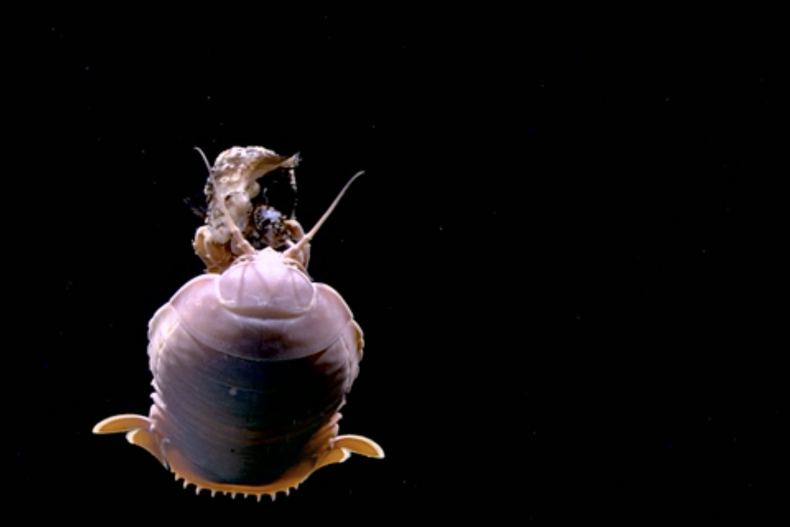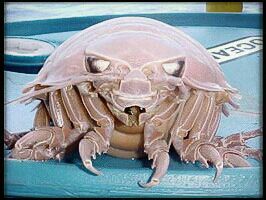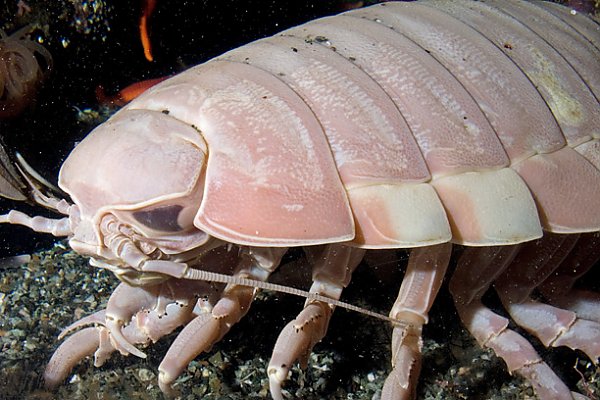A creepy video captured during a research dive off the coast of Florida shows a deep-sea creature feasting on the head of a fish.
The video was featured in the NOAA (National Oceanic and Atmospheric Administration) Office of Ocean Exploration and Research’s “31 Dives of Halloween” web series, which is highlighting a host of fascinating deep-sea creatures in the run-up to the popular holiday.
The creature visible in the clip is a giant isopod of the species Bathynomus giganteus—a deep-sea scavenger that is a close relative of the pill bugs and sowbugs commonly found in homes and gardens.

Isopods are a type of crustacean that lives in both the ocean and terrestrial environments, of which there are about 10,000 species around the world.
A giant isopod eating a fish
Above, a giant isopod feasts on a fish in the deep sea around 40 miles southeast of Key West, Florida. Giant isopods are an example of deep-sea gigantism. NOAA Office of Ocean Exploration and Research
Giant isopods, which belong to the genus (group of species) Bathynomus, are the largest of all isopods. They can grow much larger than their terrestrial relatives capable of reaching lengths of up to around a foot-and-half in length.

“Giant isopods are an example of deep-sea gigantism, which is where deep-sea animals grow exceedingly large,” Stephanie Farrington, the biology science lead for the expedition during which the footage of the giant isopod was collected who is now working with NOAA Fisheries, told Newsweek.
“It is thought that this phenomenon increases efficiency, and thus food scarcity in the deep ocean may have led to the evolution of gigantism. Colder water also has a correlation with larger body size—typically the temperature of the bottom of the ocean is close to freezing,” said Farrington, who specializes in deep-sea biology.

The video in question was captured during an NOAA research expedition in 2019 around 40 miles southeast of Key West, Florida at a depth of almost 4,000 feet. It shows a giant isopod estimated to be around 8 inches long snacking on a fish morsel.
Though giant isopods were first discovered in 1879, there is still much about their biology and behavior we do not fully understand given that scientists have yet to conduct extensive studies on them. This is why videos such as this are so important to researchers.
“Since they live at such great depths, they are very hard to study. Until modern history, the only way for us to access them was using trawls,” Farrington said. “The advent of modern ocean exploration and deep submergence vehicles allows us to observe giant isopods in the natural environment. This in situ observation had made it possible to more frequently observe their behavior.”
While scientists have a basic understanding of their diets, breeding habits and distribution, they are still learning new things about this group of animals. A new species was described just this year from the Gulf of Mexico.

Like all crustaceans, giant isopods have a hard exterior known as an exoskeleton. The bodies of these otherworldly creatures are divided into three segments, including the cephalon (head), pereon (thorax), and pleon (abdomen), according to Farrington.
They have 14 jointed legs, a fanned tail, known as a uropod, and two sets of antennae—one long pair and one short. They also have a set of strange appendages on their abdomen called pleopods that are part of their respiratory system.
Giant isopods have been collected or sighted at depths ranging from 170 to 2,140 meters (558 to 7,020 feet) around the world, according to Farrington. Bathynomus giganteus is found mostly in the Gulf of Mexico, the Straits of Florida, and as far south as Brazil, mostly on or near the sandy seafloor.

While more than 20 species of giant isopod have been described to date, B. giganteus is the only one to Farrington’s knowledge that is found around the United States, with the exception of the newly identified species from the Gulf of Mexico.
Giant isopods are thought to have existed for more than 160 million years, evidence from the fossil record indicates.
Giganteus is not on the endangered species list but it does face a number of threats. Hard-bodied invertebrates (those that have calcified body parts) are subjected to the threat of ocean acidification, which is a decrease in the ocean’s pH caused by the increase in greenhouse gasses being absorbed into the ocean.
“Ocean acidification can literally dissolve or prevent the formation of calcium carbonate in shells and exoskeletons,” Farrington said.
These animals are also subjected to plastic pollution and can be inadvertently caught by deep-sea trawlers.




